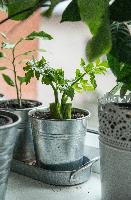
If you’re looking to reduce food waste while saving money on your grocery bill, one thing you can do is regrow the fruit and veggies you bought from the grocery store. It's a simple yet clever hack, but first you have to know which produce will resprout...
The two ways to regrow veggies
 Francesco Gallarott
Francesco Gallarott
There are two main ways to regrow fruit, vegetables and herbs from scraps. One is to place the scraps in water and wait for them to grow roots. Once they're big enough, transplant them into a soil-filled planter.
The other way is to simply plant the scraps or seeds directly in soil, water them, and wait to see sprouts emerge.
Things to keep in mind before getting started
Before getting started, check online to see how much sunlight and water each type of fruit or vegetable needs to thrive.
Does your space get enough sunlight?
Make sure you place plants that require ample sunshine either outside (depending on the season) or near a window. It is definitely possible to regrow veggies in apartments—even if you don’t have a patio—as long as you have windows where the ones that need lots of sun can sit.
Craft a watering schedule
If you're regrowing a variety of produce, make a list of when to water each and post it somewhere you will see each day.
How to regrow green onions
 Laura Mitulla
Laura Mitulla
Green onions are one of the easiest plants to regrow, making them a great starter for first-time veggie regrowers. My favourite thing about replanting green onions is that when I’m cooking, I can snip off just as much as I need and it will grow back within a few days.
To regrow green onions, first choose whether you want to plant them in a small jar of water or in soil.
Regrowing in water: Put the white bulb ends in a jar of shallow water and in a few days you will see new green growth. You will also see the white ends sprout slender white roots. Position the jar on a windowsill and transplant them into soil once they have roots and some green growth on top.
Regrowing in soil: Bury the white bulb in potting soil, leaving the green part exposed.
How to regrow celery and lettuce Milada Vigerova
Milada Vigerova
 Milada Vigerova
Milada VigerovaFor celery and lettuce, place the root base of the veggie (the part you wouldn't normally eat) with about two inches of the plant still exposed in a shallow dish of water. Replace the water every day. After a few days you will see the top of the plant begin to sprout new leaves. At this point, plant your revitalized celery or lettuce in a pot of soil.
Important: Make sure to only bury the root base of the veggie in the soil while keeping the new leaves exposed.
How to regrow peppers, chillies and tomatoes
 Mockup Graphics
Mockup Graphics
To regrow bell peppers, chilies and tomatoes, all you have to do is separate the seeds from the flesh of the vegetable. Place the seeds directly into soil and water immediately. Continue to water regularly. Within a week or so you should see some small green sprouts emerge from the soil. You will have to wait a much longer time to harvest these veggies but trust me, it’s worth the wait.
How to regrow potatoes
 JE Shoots
JE Shoots
To regrow potatoes make sure that you cut off a piece of the potato that has a small growth (a "tuber") or "eye." Make sure the piece is a few inches long. Leave any pieces that you plan to plant on a surface where they can dry out. Allow them a few hours to completely dry.
When you plant the potato pieces, dig a hole in the soil and place them with the cut side facing down and the eyes or tubers facing upwards. Cover them with soil. Ensure the potato slices aren’t cramped together when planting so they have lots of room to grow. Water daily until you start to see green sprouts emerge from the soil.
How to regrow garlic
 Mockup GraphicsOften when I buy garlic I only want to use a few cloves at a time, rather than the entire bulb. Simply regrow the cloves you don't eat.
Mockup GraphicsOften when I buy garlic I only want to use a few cloves at a time, rather than the entire bulb. Simply regrow the cloves you don't eat.
To regrow garlic, remove the outer skin that covers the entire bulb and separate the garlic into individual cloves, leaving the skin that covers each individual piece intact. Plant the cloves facing upwards, five inches apart and two inches deep. Water and wait to see new growth burst through the surface of the soil.
These tips should have you starting your own at home garden in no time. Happy planting!

P.S. Ever consider your laundry waste?
Did you know that annually more than 750 million plastic laundry jugs end up in our landfills? Tru Earth has the solution.
